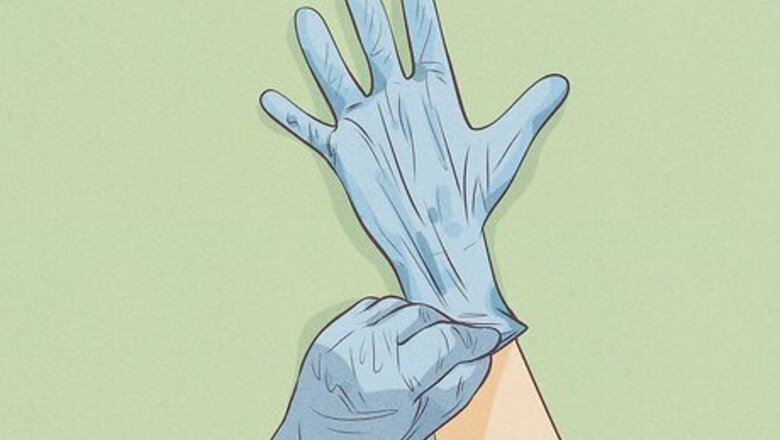
views
Applying the Dye to a Strand
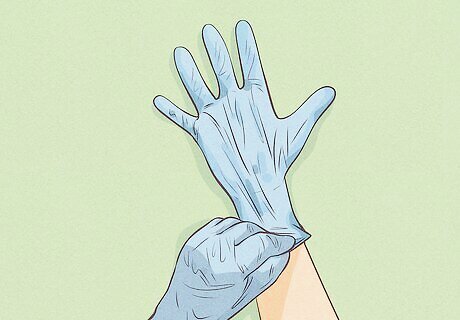
Put on disposable gloves. Pull on the plastic gloves provided in your dyeing kit to protect your hands from the chemicals in the dye. You should leave these gloves on throughout the strand test. If you don’t have gloves included with your dyeing materials, purchase any disposable latex or latex alternative gloves from the store. It’s important that you avoid contact of the dye with your skin. Many products contain dyeing agents that are toxic and can stain the skin. If you do get dye on your skin, rinse with warm water as soon as possible. For more stubborn stains, use olive oil, baby oil, or a gentle soap or laundry detergent.
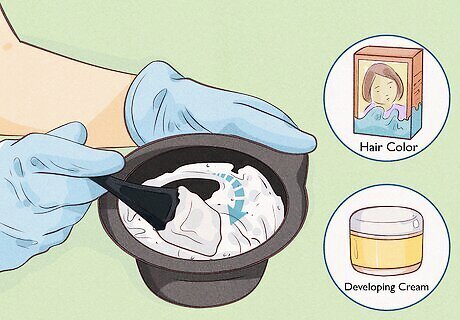
Mix developer and dye in a bowl. Squeeze 1 teaspoon of hair color and 1.5 teaspoon of developing cream into a plastic bowl and mix together thoroughly with a plastic spoon or applicator brush if you have one. It’s best to use a disposable bowl or cup and spoon, as the dye can stain the bowl and utensil permanently. Follow your specific dyeing instructions if they suggest different quantities of color and developer. You need only a very small amount for one strand of hair.
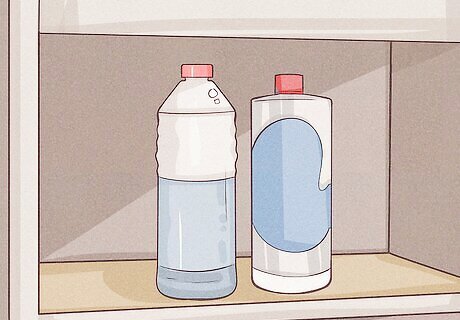
Return caps to bottles and store. Screw the caps back onto your color and developer bottles and store them in a cool, dry place until you use them for your full hair dye. Don’t mix the rest of your dye ahead of time. Mixed dye should be used on hair right away and not stored. Clean up any spills with warm water and soap or oil if necessary to fully remove any drops of dye on a sink, counter, or other nearby surfaces.

Isolate an unnoticeable strand of hair. Separate a strand of your hair that doesn’t often show in whatever style you most commonly wear your hair in. Clip back the surrounding hair so that it doesn’t get in the way or get dyed accidentally. Try a section near your ear for an easily accessible and often hidden strand. You can also pick a strand near the back of your head, but avoid choosing one somewhere obvious like the top of your head. Separate a strand that’s at least an inch wide for a more accurate representation of what a larger quantity of hair will look like once dyed. Choose a strand that includes some gray hairs if you aim to cover grays with this dye. You may perform this test by cutting a smaller strand of hair off to dye it, but note that this will only test for color results, not allergic reactions. Lorri Goddard-Clark Lorri Goddard-Clark, Hair Colorist If you want to dye just a few strands of hair, use a small brush or toothbrush to apply the color. This will give you more control and prevent the color from getting on the rest of your hair.
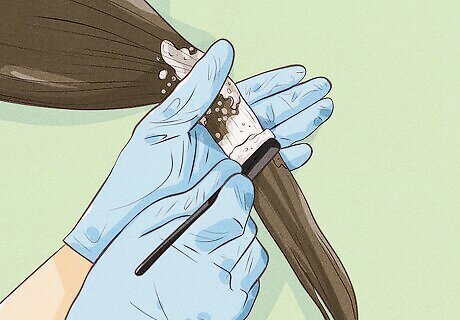
Apply the mixed dye to the strand. Use an applicator brush, comb, or your gloved fingertips to apply the mixed hair dye from your bowl to your separated strand of hair. Make sure to work the dye through the hair strand thoroughly from root to tip as you would when dyeing normally and according to your instructions. Try to apply to roots as close to the scalp as possible without getting dye directly on the skin of the scalp. If this is your first time dyeing your hair, apply dye to the middle of your hair strand and leave it in for 15 minutes before you apply to the roots and ends. Dye processes more quickly at the roots of hair due to heat from your scalp, as well as at the ends due to dryness, so this application may help to create more even color. If you’ve dyed your hair previously, apply the current dye to your strand of hair at the roots down to where your previous dye color shows and leave it in for 15 minutes before adding color to the rest of the strand. This will help even out possible differences in color between previously dyed hair and undyed roots.
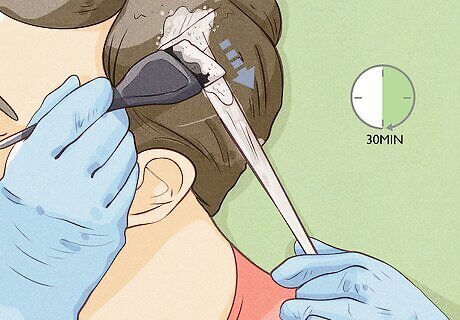
Leave the dye on the strand for about 30 minutes. Wait about half an hour or whatever duration your specific instructions recommend. Take care to keep the dyed strand from touching any other hair, your skin, or clothes during this time. You can wrap your dyed strand in tinfoil or plastic wrap to protect it if you wish. Note that this can also accelerate the dyeing process and result in stronger color due to the heat insulated within.

Rinse and dry the strand. Rinse out the dye from your strand of hair with warm water until the water runs clear, then blow dry or let it air dry. Don’t use shampoo on your hair right away, but you may use a small amount of conditioner after the rinse if you wish. Try to keep the strand isolated during rinsing and drying so you can more accurately compare and determine the results.
Determining the Results

Wait 24 hours for best results. Wait another 24 hours after your strand dries to determine the results of the test. This will allow any allergic reactions to fully develop, and let you observe the color of the dyed strand in different lights. Pay attention to the color of the hair, as well as the quality of the hair after it's dyed. If you know you are not allergic to the ingredients in your particular dye, you can perform the full dye on the rest of your hair right after the strand test, though waiting a full day can still be beneficial to help you get a better idea of the color. During the 24-hour period, test the condition of your hair by feeling its texture compared to your non-dyed hair and stretching out an individual hair to see how it behaves. Damaged hair will feel dry or coarser than normal, and will not resume its normal shape or length after being pulled. To do a more accurate allergy test, you should perform a separate patch test by applying a small amount of dye to your inner elbow and observing your skin after 48 hours. If you notice any redness, itching, swelling, or pain with either a strand or patch test, you should wash off the dye immediately and not use it again.
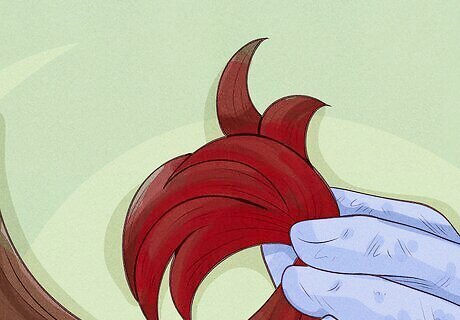
Observe if the color is too dark. Look at your dyed strand when it is fully dry. If the color is darker than you wanted, leave the dye on for a shorter period of time or select a lighter shade when you dye your full head of hair. The color on your hair strand may turn out darker if your hair is dry and brittle from excessive heat exposure or previous dyes. You may want to treat dry hair for a few weeks or months before you do a full dye. Color can also turn out darker if your hair is currently a lighter shade or if you’ve had it previously bleached or permed.
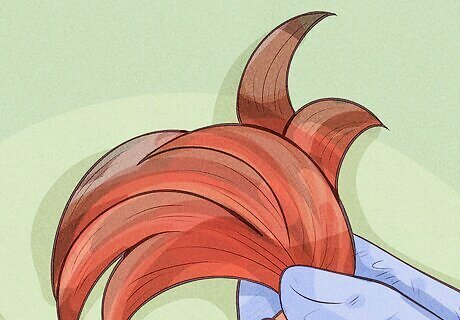
See if the color is too light. Observe your fully dried hair strand to see if the new color is lighter than you want or expected. If so, leave the dye in for longer or select a darker shade of dye when you treat your full head of hair. Your hair may not take the color as well if it has been recently shampooed or if you have previously colored your hair using henna, which can leave a residue that prevents dye from working as well. You may want to leave your hair color in longer, and apply it when your hair has not been washed in a couple of days. Hair dye also may not bind to your hair as well if you’re taking certain medications such as thyroid treatments, certain hormone therapies, or chemotherapy. You should apply dye when you are not taking these medications if possible, and consult a doctor or pharmacist to be sure that hair dyes will not interfere with the performance of any medication.
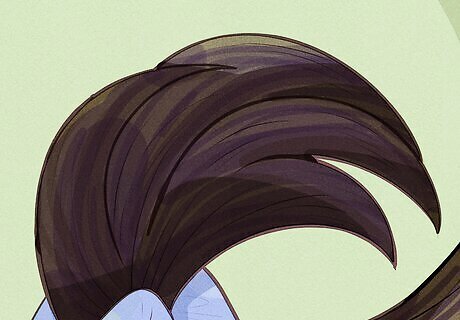
Determine if the color is otherwise unexpected. Look at your dyed strand of hair when it is dry to see if it is a different tone or color than you were expecting. You will likely want to purchase a different shade for the full hair dye if this is the case. If the color is too red, yellow, or “brassy,” try a dye with “ash” in the name of the shade (like “ash blonde” or “ash brown”) to neutralize it. You can mix the ash shade with your current shade to achieve the desired color. You may want to do another strand test after mixing the two shades. If the color is not covering gray hair, you may need to leave the dye on for a longer period of time (see your specific dye instructions) or apply a cover or heat to your hair while the dye sits.
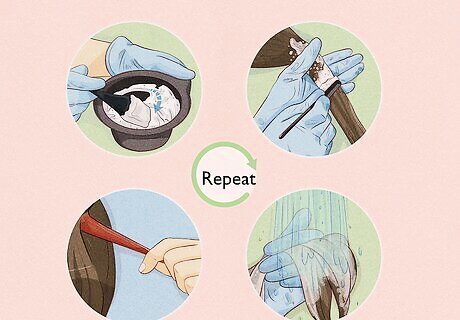
Proceed with your full dye or another strand test. Replicate your exact process during the strand test when you use the full amount of dye on the rest of your hair. If you weren’t happy with the strand’s color, do another strand test with a new shade, mix of shades, or a different time period/heat application to achieve the desired results. If you do another strand test, isolate a different strand of hair than the one you used for the first test.




















Comments
0 comment